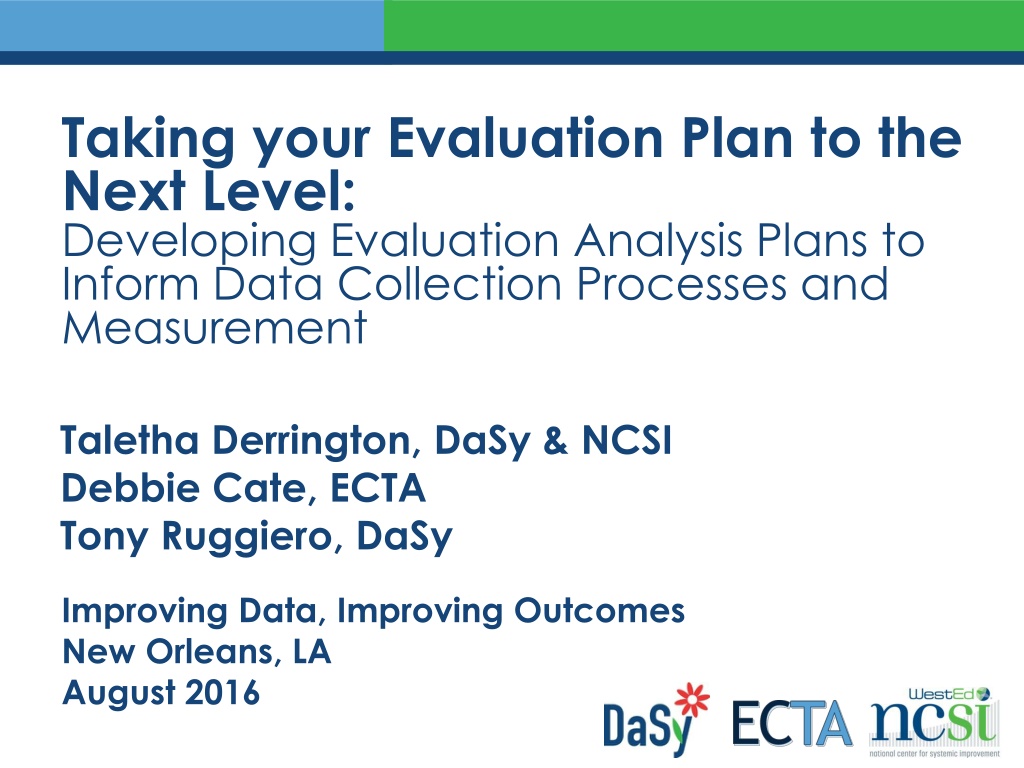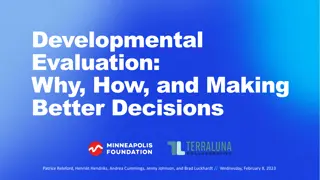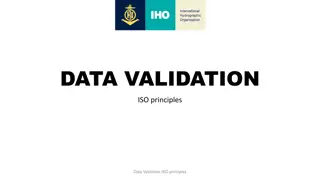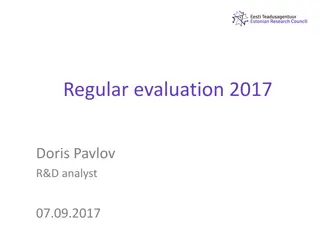Developing Effective Data Analysis Plans for Evaluation Processes
Explore essential elements of analysis plans to enhance data collection and measurement strategies. Learn how to identify key components, types of data considerations, and apply guiding questions for effective analysis planning in evaluation processes.
Download Presentation

Please find below an Image/Link to download the presentation.
The content on the website is provided AS IS for your information and personal use only. It may not be sold, licensed, or shared on other websites without obtaining consent from the author. Download presentation by click this link. If you encounter any issues during the download, it is possible that the publisher has removed the file from their server.
E N D
Presentation Transcript
Taking your Evaluation Plan to the Next Level: Developing Evaluation Analysis Plans to Inform Data Collection Processes and Measurement Taletha Derrington, DaSy & NCSI Debbie Cate, ECTA Tony Ruggiero, DaSy Improving Data, Improving Outcomes New Orleans, LA August 2016
Session Objectives Identify essential elements of an analysis plan Summarize types of data and analysis considerations Apply essential elements and guiding questions to begin developing an analysis plan 2
Session Outline Essentials of data analysis plans Evaluation plan components and data analysis Types of data and analytic methods Developing analysis plans two examples Small group practice Work on your own plans! 3
Analysis Plans & the DaSy Framework Quality Indicator DU1: Part C/619 state staff plan for data analysis, product development, and dissemination to address the needs of the state agency and other users. Quality Indicator DU2: Part C/619 state staff or representatives conduct data analysis activities and implement procedures to ensure the integrity of the data. http://dasycenter.org/resources/dasy-framework/ 4
Essential Elements of a Data Analysis Plan Purpose of the analysis Description of the general topic of analysis Details for the analysis that specify: What topic to be analyzed Why hypotheses or rationale How specific variables, types and order of analyses Documentation of decisions and findings DaSy & ECTA, 2015 5
Essential Elements of a Data Analysis Plan Details for the analysis that specify: What topic to be analyzed Why hypotheses or rationale How specific variables, types and order of analyses DaSy & ECTA, 2015 6 6
Evaluation Plan Outputs and outcomes Questions and design Data collection strategies Timeline for evaluation activities Plan to share and use results Plans for data analysis Adapted from: Nimkoff, Schroeder, & Shaver, 2016 7 7
Developing Data Analysis Plans Data collection strategies: measurement & data collection methods Questions and design: performance indicators Plans for data analysis 8 8
Data Analysis Plan Details: What are you analyzing? Performance indicators Piece of information that measures (indicates) whether outcomes are being achieved, i.e. performance. Evidence that will allow the SSIP Team to track change or progress. Other factors that might influence performance Time When implementation occurred Child, family, program, and/or community characteristics 10
What is a good performance indicator? A few criteria: 1. The indicator is clearly related to the outcome and is a measurement of the outcome. 2. Usually contains a statistic, a number (e.g., a percentage, an average, a total) to track to see whether it goes up or down. 3. State whether you want to see an increase or decrease. 4. The wording of an indicator should suggest how you are going to measure the outcome. 5. Feasible for you to collect the data. 11
Well-written Performance Indicators An increase (direction) in the average score (number) on the Proficiency Test given at the end of training (method of measurement) An increase (direction) in the average score (number) on the Provider Skills Checklist (method of measurement) 12
Types of Data and Analysis Considerations Types: Performance indicators & other factors can be Numeric (e.g., SS1, SS2) Categorical: ordered (e.g., age group) or non-ordered (e.g., ethnicity) Qualitative (e.g., responses to open ended survey or interview questions) Considerations: All types of data often need transformation to be analyzed Create groups from numbers or bigger/different categories Themes from qualitative data Different comparisons and statistical techniques are appropriate for different types of data 13
Analysis of Implementation Activity How Will We Know the Activity Happened According to the Plan? (performance indicator) Measurement / Data Collection Methods Analysis Plan Infrastructure: State lead agency (SLA) develops process for using COS data to assess progress and make program adjustments. All local lead agencies (LLA) complete steps in self-assessment tool to use data for program adjustments Review of all LLA self-assessments by SLA staff ? 14
Essential Elements of a Data Analysis Plan Details for the analysis that specify: What topic to be analyzed Why hypotheses or rationale How specific variables, types and order of analyses 15
Analysis of Implementation Activity Performance Indicator Measurement / Data Collection Methods Analysis Plan Infrastructure: State lead agency (SLA) develops process for using COS data to assess progress and make program adjustments. All local lead agencies (LLA) complete steps in self-assessment tool to use data for program adjustments Review of all LLA self-assessments by SLA staff What specific data, or variables, are we going to collect? Will we need to transform the data? How will we organize the data? What types of analyses or data displays do we want? 16
Developing a Data Analysis Plan Variable: LLA completion of self-assessment How do we know it is completed? What specific data do we collect during review? Transformations: 10 steps in self-assessment Numeric: % of steps completed? Categorical: all completed / not all completed? Data organization: create a database Types of analyses/data displays: Trend analysis using chart of % of completed self-assessment steps for each program 17
Types of Analyses/Data Displays Roll Out 1 Roll Out 2 100% Pgms 2, 6, 8, 9, & 10 Pgms 3 & 5, 0.9 % of SA Steps Completed 80% Pgms 1 & 7, 0.8 60% Pgm 4, 0.6 40% 20% Jul 16 - Jun 17 Jul 17 - Jun 18 Jul 18 - Jun 19 19
Analysis of Implementation Performance Indicator Measurement / Data Collection Methods Analysis Plan All local lead agencies (LLA) complete all 10 steps in self- assessment tool to use data for program adjustments Review of all LLA self-assessments by SLA staff, and count the number of the steps in the SA that were adequately completed. Provide definition/guidance/ examples of adequate completion. Variables: LLA completion of self- assessment (SA) measured by % of the SA steps completed each year, measured annually. Comparisons/data display: graph the % of steps completed for each LLA each year; plot lines to measure when state disseminated the process; watch for increasing or decreasing trends and time from dissemination to inform adjustments 20
Questions? 21
Analysis of Long Term Outcomes Outcome Evaluation Question(s) Performance Indicator Measurement/ Data Collection Methods More EI enrollees will demonstrate greater than expected growth in social-emotional (SE) skills upon exit from EI Did children who entered EI with SE COS 5 in SE substantially increase their rate of growth by the time they exited EI? At least 50% of children who entered with SE COS 5 shifted from OSEP progress category b to categories c or d. COS ratings at entry and exit captured in state data system 22
OSEP Progress Category & Summary Statement Refresher OSEP progress categories (a, b, c, d, e) are calculated from two COS ratings and two different time points (for federal reporting, at entry and exit from EI/ECSE). Summary statement 1 = (c + d)/(a + b + c + d) A shift of children from b to c or d would put them in the numerator as well as the denominator and increase SS1 HOWEVER 23
Analysis of Long Term Outcomes Outcome Evaluation Question(s) Performance Indicator Measurement/ Data Collection Methods More EI enrollees will demonstrate greater than expected growth in social-emotional (SE) skills upon exit from EI Did children who entered EI with SE COS 5 in SE substantially increase their rate of growth by the time they exited EI? At least 50% of children who entered with SE COS 5 shifted from OSEP progress category b to categories c or d. COS ratings at entry and exit captured in state data system 24
Developing a Data Analysis Plan Variables: midway OSEP progress category, exit OSEP progress category, shift from b to c or d, program ID, exit date, disability category, length of service category. Transformations: calculate the shift variable from the midway and exit progress categories as yes/no; calculate length of service as 12 mo. or > 12 mo. 25
Developing a Data Analysis Plan Data organization: create a mock database, consider if you can add variables to your state s data system 26
Developing a Data Analysis Plan Analyses/data displays: Every 6 months Calculate the % of children who shifted overall and by program ID, disability category, and length of service category. Prepare trend line graphs over time by program ID, disability category, and length of service category. Perform chi-squared comparisons of shift by disability category and by length of service category . Use Meaningful Difference calculator (p < .10) to compare program % and state %. 27
Analysis of Long Term Outcomes Performance Indicator Measurement / Data Collection Methods COS ratings at entry, midway through enrollment, & exit; midway & exit progress categories captured in state data system Calculate midway to exit category shift Begin after 1 year of implementing new midway COS ratings; calculations every 6 mo. Analysis At least 50% of children who entered with SE COS 5 shifted from OSEP progress category b to categories c or d. Variables: midway and exit OSEP progress categories; shift from b to c/d; program ID; exit date; disability category; length of service (LOS) category Transformation: calculate LOS category Data organization: add midway COS rating & OSEP progress categories to state data system; create report for analytic dataset to calculate shift. Analyses/data displays: Calculate the % of children who shifted by program, disability category, and LOS category; time trend line graphs; chi squared & meaningful difference analyses (details). 28
Analysis of Short Term Outcomes Outcome Evaluation Question(s) Performance Indicators Measurement / Data Collection Methods Analysis Staff / contractors have increased understanding of the child outcomes summary (COS) rating process Did staff and contractors participating in training master the foundational knowledge and skills required in the COS process? Among trained staff and contractors: 100% take the COS- CC check 80% pass the COS- CC Child Outcome Summary Competency Check (COS- CC) Variables? Transformations? Data organization? Analyses/data displays? Do we need to revise performance indicators or measurement / data collection methods? 30
Analysis of Intermediate Outcomes Outcome Evaluation Question(s) Performance Indicator Measurement /Data Collection Method Analysis Teams complete COS process consistent with best practices To what extent do teams implement the COS process as intended, consistent with best practices? 75% of teams observed meet established criteria on the adapted COS-TC checklist. Adapted COS- TC checklist completed by peer coach Variables? Transformations? Data organization? Analyses/data displays? Do we need to revise performance indicators or measurement / data collection methods? 31
Resources DaSy & ECTA. (2015). Planning, conducting, and documenting data analysis for program improvement. http://dasycenter.sri.com/downloads/DaSy_papers/DaSy_SSIP_DataAnalysisPlanning_20150323_FINAL_A cc.pdf Derrington, T., Vinh, M., Winer, A., & Hebbeler, K. (April-May, 2015). The Data Are in the Details: Translating Evaluation Questions Into Detailed Analytical Questions. IDC Interactive Institutes, https://ideadata.org/resource-library/55bbb08f140ba074738b456c/. Derrington, T., Winer, A., Campbell, S., Thompson, V., Mazza, B., Rush, M., Hankey, C. (April-May, 2015). Maximize the Return on Your Data Investment: Planning and Documentation for Data Collection and Analysis. IDC Interactive Institutes, https://ideadata.org/resource-library/55c24511140ba0477f8b457d/. Early Childhood Outcomes Center, ECTA. (2009). Summary Statements for Target Setting Child Outcomes Indicators C3 and B7. http://ectacenter.org/~pdfs/eco/SummaryStatementDefinitions.pdf Early Childhood Outcomes Center, ECTA. (2012). Developmental Trajectories: Getting to Progress Categories from COS Ratings training resources webinar. http://ectacenter.org/eco/pages/selflearning.asp. ECTA, DaSy, NCSI, & IDC. (2015). Sample SSIP Action Plan Template. http://ectacenter.org/~docs/topics/ssip/ssip_improvement_plan_template.doc. Nimkoff, Schroeder, & Shaver. (May/June, 2016). SSIP Phase III: Operationalizing Your Evaluation Plan. IDC Interactive Institutes, Kansas City, MO & Savannah, GA. 35
Thanks! Taletha Derrington, taletha.derrington@sri.com Debbie Cate, debbie.cate@unc.edu Tony Ruggiero, tony.ruggiero@aemcorp.com DaSy NCSI http://ncsi.wested.org/ Twitter @TheNCSI ECTA http://ectacenter.org/ Twitter @ECTACenter Facebook https://www.facebook.c om/ecta-center- 304774389667984/ http://dasycenter.org/ Twitter @DaSyCenter Facebook https://www.facebook. com/dasycenter 36
The contents of this presentation were developed under grants from the U.S. Department of Education, # H373Z120002, #H326P120002, and #H326R140006. However, those contents do not necessarily represent the policy of the U.S. Department of Education, and you should not assume endorsement by the Federal Government. Project Officers: Meredith Miceli, Richelle Davis, Julia Martin Eile, Perry Williams, and Shedeh Hajghassemali. 37























